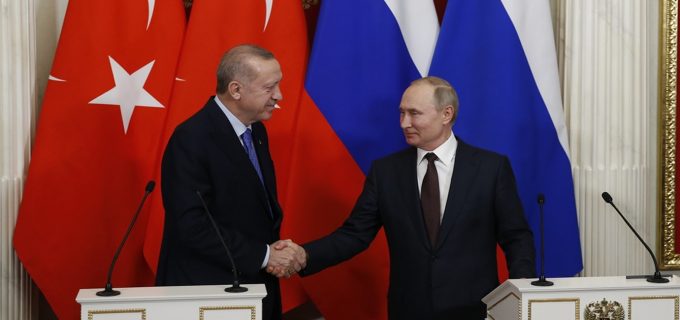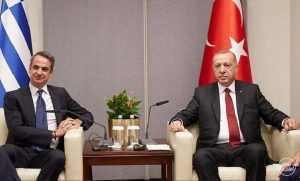Earlier in March, the Turkish army launched its Operation Spring Shield military operation in Syria. This came on the back of the latest military development in Idlib which saw the killing of a number of Turkish soldiers, and saw the Syrian opposition losing large areas it had previously controlled following rapid advancements of Syrian regime forces in the north-western regions of Syria. The most recent of these areas is the city of Idlib, bordering Turkey, and where the Sochi Agreement has been repeatedly violated – the Syrian regime continues to receive unlimited support and air coverage from Russian forces. This prompted Turkey to escalate with a force that was the strongest of its kind in Syria, and has caused political tension between Turkey and Russia and mobilisation from both parties to display their military capabilities in northern Syria.
Consequently, the Turkish President received an invitation from his Russian counterpart to discuss the implications of military developments in the north-western regions of Syria. During the visit, the Turkish and Russian presidents reached joint understandings stipulating a ceasefire and entering into new negotiations.
This report will analyse the situation based on previous agreements between Turkey and Russia regarding the Syrian file, with an explanation of the most important motives for both countries, and the extent of the new agreement’s resilience in light of previous negotiating experiences.
Background of the Turkish-Russian agreement
On March 5, 2020, after the Turkish President’s visit to Russia, a new agreement was signed with the Russian President. This agreement stipulated a ceasefire starting at 00:01 Idlib time, with the establishment of a security corridor 6 km north and 6 km south of the main international highway in Idlib, M4, which is the road linking the cities controlled by the Syrian regime in Aleppo and Latakia, with deployment of joint patrols along the M4 starting from March 15. The agreement also declared the continuation of negotiations for a new political solution.
There are a number of observations about this agreement; the most significant of which are:
- With regards to the ceasefire, this was indeed enacted on schedule, but there are transgressions which may present a cause for renewed confrontations, especially since Turkey announced that it will respond forcefully to any breach of the agreement by the regime.
- The agreement demanded the establishment of a security corridor 6 km north of the M4 and 6 km south of it. This has made the areas south of the line, which were under the control of the Syrian opposition, surrounded; implicitly making it under the control of the Syrian regime forces.
- There was no suggestion of what to do with the M5 highway, which Syrian regime forces gained control over in their latest campaign.
- This agreement came after a series of Turkish-Russian negotiations regarding Syria, and after previous agreements which had provisions that were not adhered to. This may not be reassuring for the success of the new agreement. On January 24, 2017, the Astana ceasefire agreement between Turkey, Russia and Iran was signed. Then, on May 4, 2017, the three countries reached a solution to stop any escalations and establish safe areas, known as the ‘de-escalation zones’, which are: eastern Ghouta, northern Homs, Daraa, Quneitra, Idlib and the countryside of the neighbouring governorates. Thereafter, the Syrian regime breeched the agreement and took control over a large number of these zones, after which Turkey interfered and created twelve observation points to prevent further transgressions by the Syrian regime forces. Later, it signed the Sochi Agreement with Russia on September 17, 2018, which stipulates the maintenance of the ceasefire; the establishment of a demilitarised safe zone in northern Syria, 15-20 km deep, running along the borders of Idlib; and conducting joint patrols. However, the Syrian regime, with Russian military support, did not stop attacking this area, with the pretext of fighting terrorism. Meanwhile, Turkey accused them of transferring armed factions from a number of Syrian regions to Idlib, according to statements by Turkish Foreign Minister Mevlüt Çavuşoğlu.
- Despite some observations on the agreement and the agreements that preceded it, the proclamation of continued negotiations may lead to the eventual resolution of controversial issues and urgent files, which is what Russia and Turkey are seeking.
Turkish and Russian motives
Turkey and Russia each have their own motivations with regards to the Syrian file in general, and with Idlib in particular. There are common strategic interests for both countries, and the Syrian file remains an important factor for them. Indeed, it has been a cause of tension in the relationship between both countries at times, and a factor for coming together at other times.
Turkey’s motives
During the past period, Turkey launched four military operations within the Syrian borders, namely: Euphrates Shield, Olive Branch, Peace Spring and Spring Shield. These operations had a number of objectives, the most important of which is the removal of elements of the Syrian Democratic Union Party (PYD) from the Turkish border, a party that Ankara classifies as a terrorist organisation. Other objectives include clearing the areas near the border, preventing the establishment of a terrorist corridor on its borders, and establishing safe areas in northern Syria. The Spring Shield operation is considered the most powerful of these operations.
Meanwhile, and as Turkey’s response to the EU and NATO’s weak stances, Turkey announced the opening of its borders to refugees, removing all limitations imposed on them from heading towards the European borders, which could force the EU and NATO to deal with the issue at hand and impose a no-fly zone, and provide Turkey with US air defence missiles.
Through its interference in the Syrian file in general, and in Idlib in particular, Turkey’s actions stem from a number of motives, the most important of which are:
- Idlib represents a strategic area for Turkish national security as it shares 130 km of land border with Turkey, as well as the Amanos Mountains which PKK elements previously used to carry out armed actions in the Turkish Hatay region. These armed actions involved using bombs and mortars, which led to the death of Turkish citizens. For this reason, Idlib being a national security zone is a demand that is non-negotiable for Turkey.
- Turkey is adamant on securing a safe geographical zone on its borders for the Syrians to reduce the pressure of refugees in Turkey, and to accommodate Syrian refugees inside Syria. Indeed, Turkey is the first choice of destination whenever the Syrian regime advance their forces into the liberated areas. This aggravates the suffering of the Syrian people, and simultaneously exacerbates Turkey’s anguish, especially under repeated pressure by the opposition forces. Thus, Turkey justifies its interference in the Syrian file by having a human dimension, and a moral responsibility related to the humanitarian aspect and the preservation of Syrian civilians.
- Turkey believes that its intervention in northern Syrian came as a result of three previous agreements: the Adana Agreement, the Astana Agreement and the Sochi Agreement. The Adana Agreement was signed in the nineteen nineties between the Turkish government and the Syrian regime, finalised by the late Syrian President Hafez al-Assad with the Turkish government on October 20, 1998. This led to the normalisation of the relationship between the two countries after several disagreements over the issue of borders, water, Kurds, and regional and international relations. The agreement stipulates that no activity with the aim of harming Turkey’s security and stability will be instigated from Syrian lands. The agreement also allows Turkey to intervene at a depth of 5 km into the border. Turkey seeks to amend the latter stipulation to reach 35 km into the border, as well as monitor the implementation of the previous Astana and Sochi agreements.
Russia’s motives
Russia seeks to expand into any available space, taking advantage of the burning crises in the region to strengthen its influence and increase its control. With regards to the Syrian file, Russia has several motives, the most important of which are:
- Russia has always regarded the Syrian regime as a strong ally since the Soviet era, and Syria is a strategic centre for its naval units and a supply station for Russian ships in the Mediterranean.
- Russia considers the Syrian file an outlet for it in the Middle East region whereby it may influence the region and use it as a negotiating card. Indeed, Russia has sought to have full control over Syria since 2015 by providing unlimited support for the regime’s forces – politically, militarily and economically – whilst maintaining military bases on the land.
- Russia seeks to remove the Syrian issue completely from under the Europeans and Americans. Indeed, it has been keen, since early days, to thwart the Geneva process supervised by the UN and the US, and to establish new negotiating processes directly supervised by it. The recent withdrawal of the US from the Astana Agreement suggests that perhaps a US-Russian agreement was made to allow Russia to extend its influence in Syria, or to place Russia in the Syrian file to weaken it, whilst simultaneously weakening the Turkish side.
- Forming a strong political and military lever for the Iranian presence in the region. Indeed, Russia’s intervention came at the beginning in response to Iran’s request, which together with its armed groups constitutes the main force on the ground. There has further been a need to secure international ties in the interest of the Syrian regime; this has an economic dimension with regards to the blockade of Iran and Syria. Furthermore, Iran feels that the American and Russian presence is temporary compared to Turkey’s.
- Declaring total control over Idlib means leading militarily the settlement of the Syrian issue, as well as declaring victory over Western conspiracies, as depicted by the Syrian regime and its allies. Accordingly, Russia is seeking, with regime forces, to settle the Idlib issue as a last incubator for the Syrian opposition forces.
Scenarios
Russian-Turkish relations are considered strategic but are worrisome at the same time. They are based on trade exchange in several fields, taking advantage of energy, gas and tourism. On the other hand, Russia is determined to cling to the Syrian regime and not abandon it. Meanwhile, Turkish is insisting on implementing a buffer zone plan to maintain Turkish national security, reduce refugee pressure, and escape the geopolitical isolation that will be imposed on it if its allies are displaced inside Syria.
Following the joint understandings between Russia and Turkey on the ceasefire after Turkey announced Operation Spring Shield, the short-term scene in Idlib has two main scenarios:
The first scenario: Military operations cease in Idlib and a political solution is reached, while limited skirmishes with regime forces continue.
This scenario assumes that the initial negotiations between Ankara and Moscow result in joint understandings through which they reach a new agreement for Idlib. This agreement would limit any military escalation that would affect the interests of either country in Syria, in order to preserve their strategic relationship. Turkey may continue to quietly exercise military operations, whilst simultaneously seeking to calm any conflict with Russia and prevent any direct confrontation. Meanwhile, it would continue responding to advancements by the Syrian regime forces until a political settlement is reached for northern Syria. This scenario may very well be enacted in the near future in light of current indications. What supports the likelihood of this scenario:
- It seems that the world, especially the oil-rich countries – most importantly Russia – are heading towards an economic depression that may calm the pace of conflicts in the region; it is not in Russia’s interest to continue depleting its resources in Syria.
- The Turkish President’s visit to Russia, which came in search for political solutions to avoid any option of a military confrontation with Russian forces or the relinquishment of Idlib.
- Russia’s understanding of the importance of Turkey having a military presence in Syria, and its awareness of Turkey’s fears over its national security, and its concern not to cut ties with Turkey.
- The announcement of continued Turkish-Russian negotiations regarding north Syria.
This scenario may be reinforced if Russia offered guarantees regarding the violations of the Syrian regime’s forces, as they remain a real threat to an agreement. Turkey would otherwise consider strong military tactics to enforce this option.
The second scenario: A return to military escalations in Idlib.
In light of the eagerness of the Syrian regime forces in continuing their operation, and Russia’s continued military support for it, this scenario assumes that implementing a ceasefire failed and that military confrontations would resume. What supports the likelihood of this scenario:
- Russia breaking the barrier of direct military intervention in the battle through its unlimited support of the regime forces; Russia’s direct targeting of Turkish forces; the Syrian regime’s repeated violations, and its violation of previous agreements with Russia’s support; and its continuous violation of the last agreement.
- Russia’s exploitation of the strained Turkey-US relationship and the weak response of NATO to Turkey in imposing its military options on the ground.
- Turkey’s strong adherence to safeguarding a safe area to alleviate the increasing refugee movement; Turkey’s continued military reinforcement to Idlib; and its continued responses to advancements by the Syrian regime forces.
This scenario may be reinforced if Turkey settles its relationship with the US in the near future, and in which Turkey delivers concessions to the US, such as giving up the Russian S-400 system, or disrupting it for example, providing that the US agrees to supply Turkey with the Patriot missile-defence system. An air embargo is also likely to be imposed on Idlib by NATO, in which the US is a primary force, to resolve the impasse of refugees after Turkey opened its borders with Europe. If the latter is achieved, military escalations may return anew.







